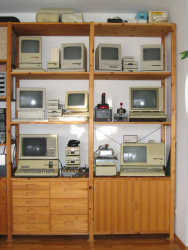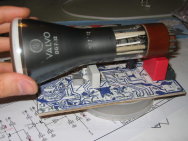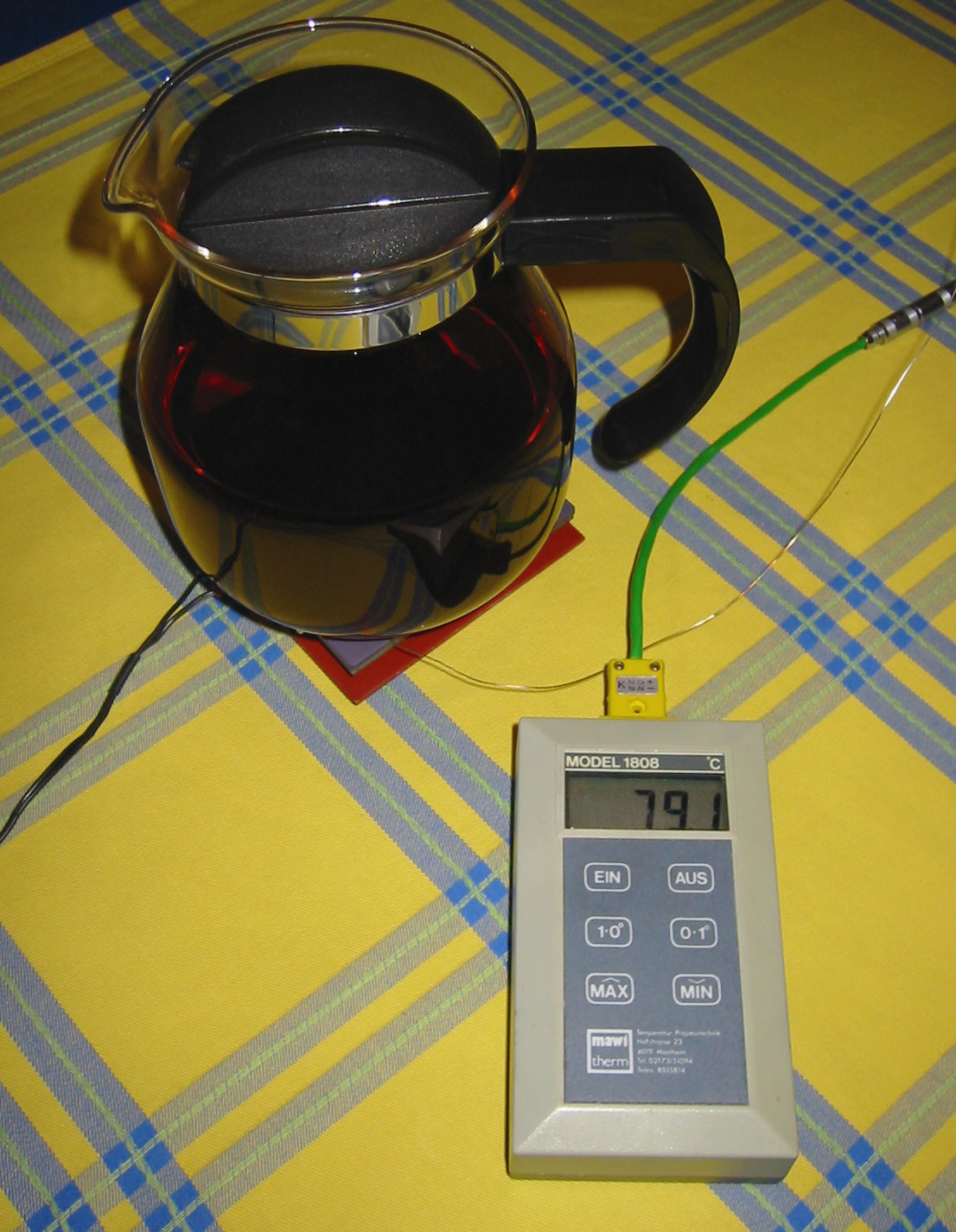Here are a few odds and ends I created during the last years. They make more or less sense, and you may find them useful or just funny. Or not at all.
I am working as a Senior Hardware Design Engineer at an automotive electronics supplier. Here I spend some time designing circuits, and most of my time making them as reliable, cost efficient and easy to manufacture as possible. Therefore sometimes it is really necessary to build something that is quite useless, but in a certain way interesting, funny or just recreative. I like vacuum tubes, I like vintage computers, and I also like robotics. And because I have some other hobbies as well (and a girlfriend who does not share this attitude), I always have more ideas than time to carry them out...
From time to time I will add some more stuff here, but do not expect too much.
 In 1984, I came across an Apple IIe computer. It was at a trade fair in our local town hall, I was thirteen years old, and I never had seen such a thing before. After that I wanted to have one.
In 1984, I came across an Apple IIe computer. It was at a trade fair in our local town hall, I was thirteen years old, and I never had seen such a thing before. After that I wanted to have one.
At that time I was not able to afford a genuine Apple (not to mention any genuine software), so one year later I got a "MEWA-48" for DM 999,- from Völkner Electronic. A real Apple II (or IIe) was 2-3 times more expensive, so almost every "Apple II" user had a Taiwanese clone. You could buy them at almost any electronic store and they came in two basic designs:
Taiwanese Apple clones were sold under different names, like "Orange II", "Telstar", "48k-Computer" or whatever. They had Applesoft BASIC inside, which was not really illegal these days because the copyright laws did not fully cover computer software. Usually the greeting string was patched to something like "HELLO" or "COMPUTER" instead of "APPLE ][", which prevented ProDOS from booting. And helped selling EPROM burners.
Many years later I bought a genuine Apple IIe at a surplus sale at our university. It was the machine Prof. Niemeyer used to work on the Hare-Niemeyer-Verfahren, a procedure to allocate the chairs of the German parliament to the political parties. This evolved into a big Apple collection. Today I own a many Apple IIplus, IIe, IIGS, an Apple ///, four Lisa 2, a Mac 128, Plus, SE, SE/30, Classic II and a Portable. And of course my old Apple clone.
Here are some documents and projects related to these great machines:
Magic Skull, Meta Pin, Hurricane, Graveyard. Here is a disk image, 1005501A.DSK, with four pinball games Thomas Jansen and I designed in Summer 1987 using Bill Budge's famous Pinball Construction Set.
And here is a disk image, 1004302B.DSK, with some puzzles for Broederbund Software's Lode Runner. Thomas and I created them around 1986 and they are really difficult, but it is possible to solve them. That time we were able to ;-) . I do not provide the game itself here because I do not know if I am allowed to. It may still be copyright-protected.
IDEfile. A ProFile / Widget emulator that allows you to connect an IDE drive or CF card to your Apple II, /// or Lisa. I do not sell these devices, but you are invited to build your own. Before asking me any questions, please read the FAQ carefully. With any questions left, don't hesitate to ask.
Eager to learn how the stuff works I did some reverse engineering to my computer equipment. As a result from this, here are a few schematics.
Lisa Keyboard Tester. This is a handheld unit that allows you to test a Lisa keyboard without having to use the precious computer. Lisa KBD scancodes are converted into RS-232, and as a gimmick it works the other way, too.
UsbWidEx is a PC-based debugging tool for Widget and ProFile devices. You can use it to backup and restore drives, to do lowlevel formatting and advanced troubleshooting. Some examples how to use it are given here. And here are a couple of logic state diagrams captured from a Widget drive during debugging.
And in case you want to take a deepe dive into the internals of a Widget, here are few logic diagrams that show the timing of different drive operations.
All vintage hard disk drives made by Apple's Disk Group are controlled by Zilog Z8 microcontrollers with fixed mask ROM. This Z8 Emulator based on an East German MMI U882 allows software modifications for diagnostics, troubleshooting or low level formatting.
Commented source code of the Apple ProFile, Widget and HD20 drive firmware can be found at Al's bitsavers.org. These files can be assembled with as, so you can create your own custom firmware for the drives. Use a Z8 Emulator to replace the mask ROM controller
I have started with a disassembly of the ProFile Z8 ROM somewhere in the '90s when I had to fix my drive (the only one I had that time ;-). Later, I worked on the Widget code as part of the research for the IDEfile project. After parts of the original Widget sources appeared at bitsavers.org, I used the original comments and variable names to replace my (partially imperfect) own remarks. The ProFile sources were finished as part of the UsbWidEx research, these are 100% based on reverse engineering. Same applies to the Widget Servo Z8 code. The HD20 code re-used parts of the Widget firmware. For these parts the original comments have been used, too.
(HD20 was a drive that could be connected to the external floppy connector of a Mac 128. It was based on a controller board (codename "Rene") with IWM and Z8 and either a Apple-made drive mechanism called "Nisha" or a RO-552 mechanism from Rodime.)
A ROM dumper for the COP400 microcontroller family from National Semiconductor. These are 4 bit microcontrollers with 512, 1024 or 2048 bytes mask ROM. Two of them live inside the Lisa -- one controls the spindle motor of the Widget hard drive, the other one takes care of keyboard, mouse and time of day.
And here are two COP4 emulator PCBs that can be used to replace broken COP420/421 with a ROMless device.
...

Sascha Ittner inspired me to design my own ScopeClock. My design is similar to his, therefore I do not describe it in detail here. It is operated by a pre-production Atmel AT89LP4052 running at 20 MHz and uses a Valvo DG7-32 tube. I used Sascha's fonts and a big part of his code, but had to make several modifications and tweaks to match it to my hardware.
The PWR/ADA-IO is a module for the c't-Lab test and measurement system. I created it together with Stefan Diestler, who had the idea of combining an IFP, an ADA-C, and an IO8-32 into one module and did most of the PCB artwork. Here are schematics, user manual, gerber files, and a front panel design.
486 Teapot Warmer: when the first processors came up that required cooling, I have built a hotplate from four 80386DX-25 CPUs. These were supplied with 5V, overclocked at 33MHz and wired in a way that the execute "XOR AX, AX" or something similar I do not remember today. Since then this thing keeps my coffee mug on temperature in my office.
A few years later, after the first i486 appeared in the scrap container, I decided to build the "MK II" version. Four i486SX-20 generate enough heat to keep a teapot on temperature. Again the CPUs were overclocked by 30% and they were in a way that they execute something useless. That was necessary because otherwise they go into some kind of idle mode (though SpeedStep was not invented yet) and you don't get the maximum power consumption. Power comes from a 6V "wall wart".
 |
 |
Of course its obvious to build the next one from four Intel Pentium processors. It would definitly beat the candle-operated units. Unfortunately there are many pins to connect, with a 1.27 mm pin spacing that does not match the regular Vero boards. A Pentium 166 consumes up to 4.5 A at 3.3 V, so it all boils down to a (four-layer!) PCB. And up to now I did not feel like designing that. If you do, please let me know.
Please do not ask me for step-by-step building instructions or technical details. I have built these units almost ten years ago and no design notes survived. In 2011 I have submitted this device to a Computer Scrap Recycling Contest held by the German computer magazine c't but it did not qualify for a prize :-(
MIDIbox SID V2 is a do-it-yourself synthesizer project invented by Thorsten Klose. At its heart is the famous 6581 sound chip from MOS Technology. It is controlled by a PIC microcontroller running Thorsten's MIOS operating system with the MIDIbox application. The PIC offers both a MIDI connection and a user interface for manual control. Based on an originally modular structure, there are a couple of excellent all-in-one implementations available.
Here is my version on two PCBs in euroboard format. The physical appearance is slighly inspired by the sammichSID, but layout and features are different.
...
This web page has been created by
Dr. Patrick Schäfer
Drei Schepps 26
D-44227 Dortmund
Germany
dr.p.schaefer@gmx.de
As I cannot take any responsibility for anything outside my reach, I explicitly disassociate myself from the contents of any page linked here.